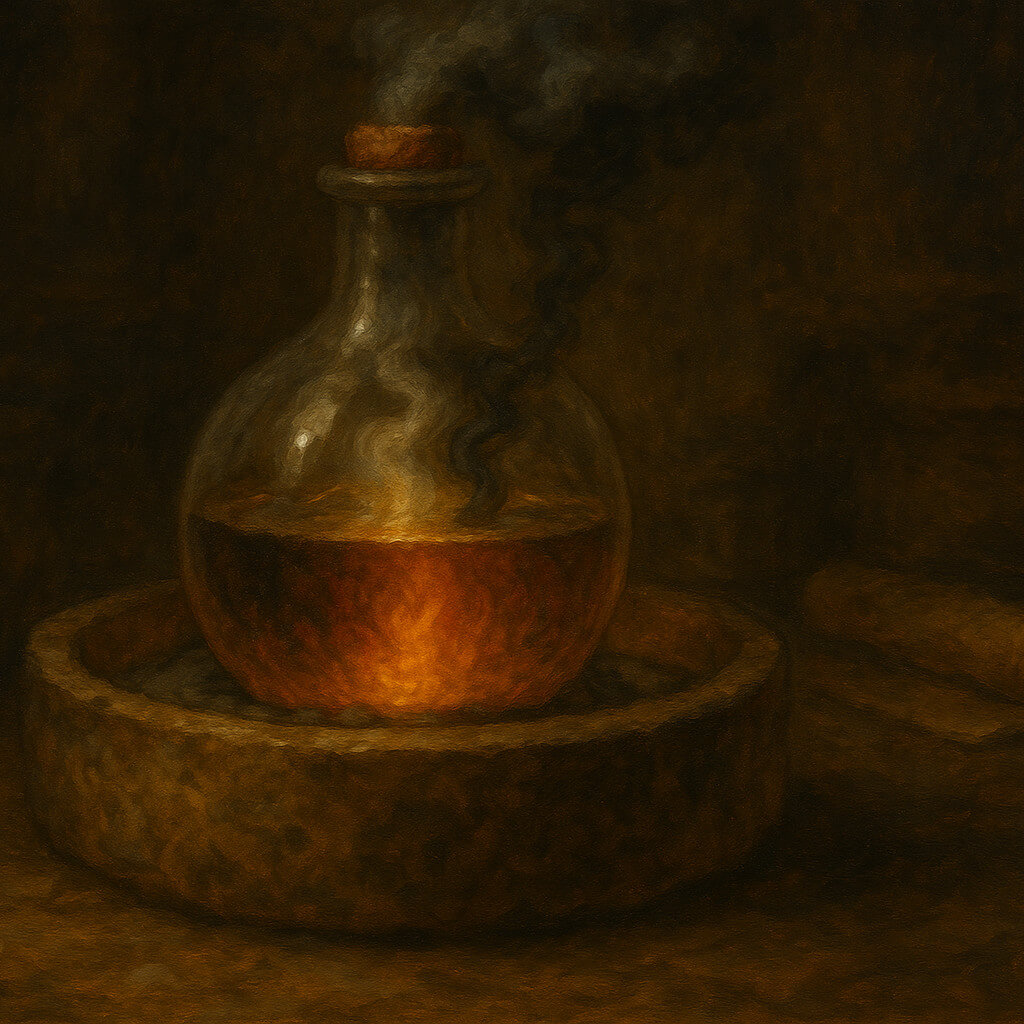Philosopher’s Stone Part Three: The Secret Book of Artephius (12th Century) — Deciphering the Method

The Secret Book of Artephius (12th Century) — Deciphering the Method
Bibliographic Introduction
The Secret Book of Artephius is one of the earliest complete Latin treatises dedicated to the philosophers’ stone. Attributed to a mysterious figure named Artephius, the text most likely belongs to the early twelfth century. The author’s identity has never been established; some traditions claim he was a Moor of Andalusia, others a Christian scholar. The text itself presents Artephius as a master who has lived for over a thousand years by means of the Stone’s elixir—an impossible claim, yet one that helped cement his authority.
The version analyzed here comes from the English translation preserved in Lapidus’ In Pursuit of Gold (London, 1976). It circulated widely in manuscript and early print, and was cited by major adepts such as Roger Bacon, George Ripley, and Eirenaeus Philalethes. For our purposes, Artephius is significant not because of his legendary biography, but because he is the first Latin author to describe the Stone’s creation in a sustained sequence of operations.
Philosophical Mercury in Artephius
Artephius makes antimony the cornerstone of his doctrine. He declares:
“Antimony… contains in itself argent vive, in which no metal is swallowed up, except gold, and gold is truly swallowed up by this antimonial argent vive. Without this argent vive no metal whatsoever can be whitened” (p. 375).
Here we meet his version of philosophical mercury. It is not common quicksilver but the mercurial spirit hidden within antimony. This argent vive has a unique affinity for gold, which it alone can dissolve. By drawing out this spirit, Artephius believes the alchemist gains access to the true mercury of the philosophers.
At the same time, he speaks of a “living water” or “moist fire” that is at once vinegar, virgin’s milk, balneum Mariae, and Azoth:
“Our water… is the oil, the dissolving water, the fountain, the Balneum Mariae, the praeternatural fire, the moist fire, the secret, hidden and invisible fire” (p. 381).
This water is not literal fire, but a solvent derived from antimony and mercury, a menstruum capable of dissolving metals and bringing them to putrefaction. Philosophical mercury, then, is not a single thing in Artephius—it is both the hidden mercury of antimony and the living water prepared from it.
Extracting the Method
From Artephius’ dense allegories, the operative sequence can be drawn out step by step:
-
Subject matter: Antimony, prepared to reveal its hidden argent vive. This is the source of philosophical mercury.
-
Preparation of the menstruum: A “moist fire” or living water distilled from antimony, mercury, and gold.
-
Union with Sol and Luna: Gold (Sol) and silver (Luna) are dissolved into this water, a process he calls reincrudation—returning bodies to their first matter.
-
Sealed vessel: The matter is placed in one glass vessel, tightly sealed.
-
Continuous gentle heat: A fire as gentle as a hen brooding her eggs. This heat is never extinguished.
-
Stages of transformation: Putrefaction (blackness), then whitening, and finally rubedo. Artephius insists these color changes are literal signs.
-
Final product: An “incombustible oil” or fixed tincture capable of multiplying without loss.
He insists over and over that there is but one vessel, one matter, one fire, one operation. This mantra is meant to cut through the proliferating recipes of his time, yet it is paradoxical—his own instructions name a complex array of substances under multiple veils.
Evidence of Practice
Certain details suggest laboratory familiarity. Artephius warns of the stench of putrefaction, of the feces that settle at the bottom of the vessel, of the danger of overheating. He describes the consistency of the heat in practical analogies rather than mystical riddles. Such signs point to a writer who had handled volatile minerals and worked with sealed glassware.
Yet other features betray rhetorical inflation. The claim of a thousand-year lifespan strains credulity. His endless multiplication of synonyms—oil, vinegar, virgin’s milk, Azoth—hides rather than clarifies. His promise to reveal the “naked truth” while withholding the final secret is the familiar pose of the compiler.
The verdict is balanced: Artephius appears to have been a compiler with some laboratory experience. He probably worked with antimony and mercury, witnessed their reactions, and wrapped those observations in a fabric of inherited doctrines.
Contribution to the Stone Tradition
Artephius’ importance lies in making the Stone a coherent Latin project. From him, later authors took the emphasis on antimony, the doctrine of reincrudation, and the refrain of unity: one matter, one vessel, one fire. He provided Europe with the idea that the Stone could be made from a specific mineral subject, processed in a sealed vessel under a continuous gentle heat, passing through colors to perfection.
Compared with Pseudo-Geber, Artephius is more specific about the matter—antimony and its hidden mercury—yet more obscure in his language of solvents and fires. Where Pseudo-Geber emphasized purified quicksilver, Artephius championed antimony. Both, however, converge on the same structure: a single vessel, a long digestion, the fixation of the volatile, and the color sequence black–white–red.
Deciphered Method
If we ask what method Artephius truly suggests, it is this:
-
Take antimony as the prime matter.
-
Extract from it a living water—a moist fire that dissolves gold and silver.
-
Seal this union in a glass vessel.
-
Keep it on a gentle, unceasing heat.
-
Observe the stages of blackness, whiteness, and redness.
-
At the end, the matter becomes an incombustible oil, capable of tincturing metals and extending life.
The identity of this “living water” remains veiled, but the operations are consistent: dissolution, putrefaction, whitening, reddening, fixation.
Conclusion
The Secret Book of Artephius is not the plain revelation it pretends to be. It is a mixture of bench observation, inherited doctrine, and allegorical disguise. Yet it represents the first sustained Latin attempt to map out the path to the philosophers’ stone. It insists on antimony as the key, on mercury hidden within it, and on a solvent that is both water and fire.
Whether Artephius himself possessed the Stone cannot be known. What can be known is that he framed the work in terms that resonated for centuries: one matter, one vessel, one fire, one operation. In doing so, he helped define what generations of adepts meant by the philosophers’ stone—and left us with a method to analyze, critique, and compare against the testimonies of others.
| Author / Text | Philosophical Mercury | Preparation Steps | Union Method | Fire / Heat | Color Signs | Product Claims |
|---|---|---|---|---|---|---|
| Zosimos of Panopolis (c. 300 CE) | “Divine water” in the kerotakis; volatile spirit ascending and descending | Calcination, sublimation, distillation, washing | Circulation in sealed vessel; dissolution and recombination | Gentle, regulated heating; moist fire | Blackening, whitening, reddening | Tincture, purification of metals; spiritual rebirth |
| Emerald Tablet (Arabic/Latin, 9th–12th c.) | “One Thing” mediating heaven and earth; volatile principle implied | None explicit; “separate the subtle from the gross” | Circulation: ascent and descent of the subtle | Not named; implied gentle force | None specified; allegorical “glory of the whole” | Perfection of all things; universal power |
| Turba Philosophorum (12th c., Arabic → Latin) | Permanent water: vinegar/gum/spume of Luna; volatile-fixative solvent | Putrefaction 40 days; washing; imbibition; coagulation | Copper (sometimes with lead/tin) dissolved in permanent water | Gentle fire; sealed vessel; staged regimen | Blackening → Whitening → Reddening → Tyrian purple | Tincture of metals; Stone “not a stone”; invariable color |
| Artephius, Secret Book (12th c.) | Hidden mercury within antimony; combined with gold | Dissolution of Sol/Luna in “living water” (moist fire); putrefaction | Antimony + mercury + gold in one vessel | Gentle, continuous heat (“hen brooding eggs”) | Black → White → Red | Incombustible oil; multiplicative tincture; longevity |
